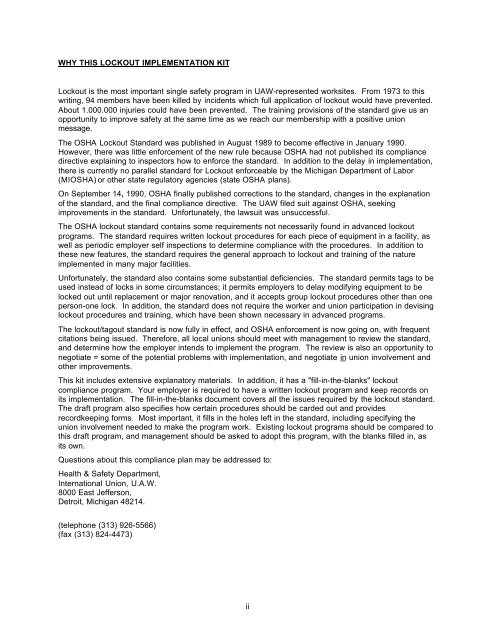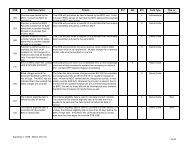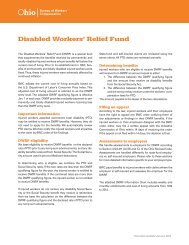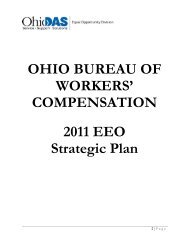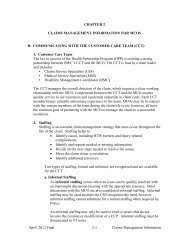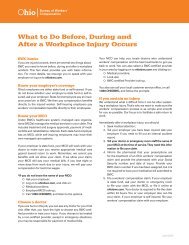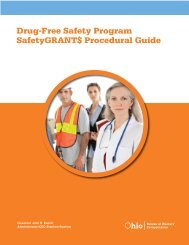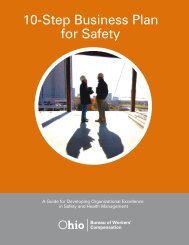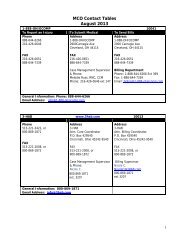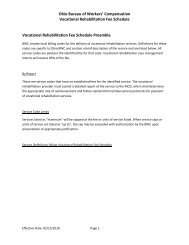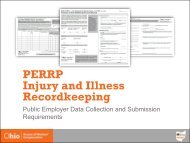Lockout / Tagout - Ohio Bureau of Workers' Compensation
Lockout / Tagout - Ohio Bureau of Workers' Compensation
Lockout / Tagout - Ohio Bureau of Workers' Compensation
You also want an ePaper? Increase the reach of your titles
YUMPU automatically turns print PDFs into web optimized ePapers that Google loves.
WHY THIS LOCKOUT IMPLEMENTATION KIT<br />
<strong>Lockout</strong> is the most important single safety program in UAW-represented worksites. From 1973 to this<br />
writing, 94 members have been killed by incidents which full application <strong>of</strong> lockout would have prevented.<br />
About 1.000.000 injuries could have been prevented. The training provisions <strong>of</strong> the standard give us an<br />
opportunity to improve safety at the same time as we reach our membership with a positive union<br />
message.<br />
The OSHA <strong>Lockout</strong> Standard was published in August 1989 to become effective in January 1990.<br />
However, there was little enforcement <strong>of</strong> the new rule because OSHA had not published its compliance<br />
directive explaining to inspectors how to enforce the standard. In addition to the delay in implementation,<br />
there is currently no parallel standard for <strong>Lockout</strong> enforceable by the Michigan Department <strong>of</strong> Labor<br />
(MIOSHA) or other state regulatory agencies (state OSHA plans).<br />
On September 14, 1990, OSHA finally published corrections to the standard, changes in the explanation<br />
<strong>of</strong> the standard, and the final compliance directive. The UAW filed suit against OSHA, seeking<br />
improvements in the standard. Unfortunately, the lawsuit was unsuccessful.<br />
The OSHA lockout standard contains some requirements not necessarily found in advanced lockout<br />
programs. The standard requires written lockout procedures for each piece <strong>of</strong> equipment in a facility, as<br />
well as periodic employer self inspections to determine compliance with the procedures. In addition to<br />
these new features, the standard requires the general approach to lockout and training <strong>of</strong> the nature<br />
implemented in many major facilities.<br />
Unfortunately, the standard also contains some substantial deficiencies. The standard permits tags to be<br />
used instead <strong>of</strong> locks in some circumstances; it permits employers to delay modifying equipment to be<br />
locked out until replacement or major renovation, and it accepts group lockout procedures other than one<br />
person-one lock. In addition, the standard does not require the worker and union participation in devising<br />
lockout procedures and training, which have been shown necessary in advanced programs.<br />
The lockout/tagout standard is now fully in effect, and OSHA enforcement is now going on, with frequent<br />
citations being issued. Therefore, all local unions should meet with management to review the standard,<br />
and determine how the employer intends to implement the program. The review is also an opportunity to<br />
negotiate = some <strong>of</strong> the potential problems with implementation, and negotiate in union involvement and<br />
other improvements.<br />
This kit includes extensive explanatory materials. In addition, it has a "fill-in-the-blanks" lockout<br />
compliance program. Your employer is required to have a written lockout program and keep records on<br />
its implementation. The fill-in-the-blanks document covers all the issues required by the lockout standard.<br />
The draft program also specifies how certain procedures should be carded out and provides<br />
recordkeeping forms. Most important, it fills in the holes left in the standard, including specifying the<br />
union involvement needed to make the program work. Existing lockout programs should be compared to<br />
this draft program, and management should be asked to adopt this program, with the blanks filled in, as<br />
its own.<br />
Questions about this compliance plan may be addressed to:<br />
Health & Safety Department,<br />
International Union, U.A.W.<br />
8000 East Jefferson,<br />
Detroit, Michigan 48214.<br />
(telephone (313) 926-5566)<br />
(fax (313) 824-4473)<br />
ii


